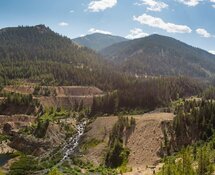Brent Cook: Mining is a tough business—a very tough business. So many things can go wrong even if the company did everything right. On the exploration side, probably 95% of the junior companies whose share prices start moving up the discovery curve finish down at the bottom of that chart. Very few actually end up with something of any real economic significance.
The main reason is that exploration is a very inexact science. In geology and exploration, we deal with a limited amount of data at the earth's surface and then use geologic models to try and understand what is happening at depth. So we are doing a lot of guessing and projecting based on a very limited data set. In fact, exploration geology is as much art as science because so much of what a geologist thinks is subjective and based on experience.
So, in the end, that fuzzy science is being applied to test some sort of geochemical or geophysical anomaly near the earth's surface. It could be slightly elevated gold or arsenic in the soil or a magnetic body of rock at depth. You have to bear in mind that an anomaly is really little more than a difference in the background values of something like soil or rock or density or magnetism. Whatever it is, the world is full of anomalies and they are not all deposits. Nature has scattered billions of geochemical anomalies all around the world, so chasing anomalies is just the nature of the game; that's what keeps us all employed in the exploration business. And failure has to be the overwhelming result when you are looking for that rare place in the earth that everything came together to form an economic deposit.
Still, all of that chasing has been very profitable to the Vancouver stock market scene; a lot of money is raised and made chasing anomalies.
TGR: So even for trained geologists like you, geology is an inexact science and you cannot know what you have until you start drilling.
BC: Basically, that's right. Drilling is a scientific tool. That's when you test your hypothesis. You hypothesize that a vein of gold, for instance, formed at 200 meters of depth under the right circumstances. More often than not, you test your thesis, get your data back, reassess the data and adjust your thesis to fit the data. That's another reason it takes so long to actually make a discovery. Putting widely scattered pieces of data together takes time.
TGR: If 95% of what appear to be good geographic anomalies fail the drill test, why does so much money chase the junior mining sector?
BC: Because if you are successful, your stock goes from $0.25 to $2.50, $10, $20. And even without an economic discovery the rewards can be enormous if you know when to get out. As I say, a lot of these stocks start up that price-appreciation curve. At some point, an investor who is well-enough informed and understands the drill results can sell that stock at a profit before the rest of the world realizes that this is a bust. So a lot of money is made on that upcurve.
TGR: That sounds like making money based on hype and not on value.
BC: A lot of hype goes on in this sector for sure, which is facilitated by the inexact nature of the science, but savvy investors really base decisions on interpreting the results as they come in. When the data start indicating that the hypothesis was wrong, they probably decide it is time to start thinking about getting out. To make money, speculators just have to recognize it before the crowd does.
TGR: Few investors really know how to interpret the data and test the thesis, as you say. How can they realistically play in that junior mining game?
BC: My honest answer is to get good advice. Rick Rule, who emceed the mining panel at the conference, runs Global Resource Investments, a brokerage firm that actually employs geologists and mining engineers as brokers. That's one good place to get advice. A good investment newsletter is another; I like mine.
Of course, a good adviser has to interpret the data correctly and say, "Look, the results from this drilling program from this project up in the Yukon aren't looking so good right now. The results are telling me we have less chance of finding something, so it's probably time to sell." Or it could be the opposite: "This is really looking interesting. Let's buy some more."
TGR: In your New Orleans presentation, you advised junior exploration sector investors to know their exit strategy. Can you expand on that in light of what you've just explained?
BC: Always buy a junior with some idea of who will buy it from you and why. My exit strategy ultimately is to invest in juniors that find deposits good enough to interest the majors. In other words, my exit strategy is to sell to someone somewhat smarter than I am—a major that knows its stuff, does its due diligence and decides to buy one of these companies. I also like to get in early on a project with the idea that as the company derisks it with drilling, metallurgy or whatever, the project fits the profile of a fund manager or someone looking for less risk and more quantifiable upside. But I think the exit strategy for most people who get into this game is to sell to someone dumber than they are, hoping the fools come in and pay more for a stock than they did. That works in a raging bull market, but not in this market. In essence, with a sound exit strategy you know 1) what the deposit the company is looking for actually looks like, 2) what it is going to take in both money and exploration to realize the deposit goal and 3) what it might be worth if all goes well—and then sell when it gets to that point.
TGR: So 95% of the time you sell to someone not so smart, and 5% of the time you hit it and sell to someone smarter.
BC: Theoretically, yes, but that assumes you buy all the stocks that start up the discovery curve and that you are right and that there is an infinite supply of dopes. It's such an inexact science, though, that even expert opinions differ. If you get five geologists in this room with me and we start talking about a property, you will hear six different opinions as to what's going on down at depth or who makes the best beer. I'm certainly not right all the time—no one in this business can be. You have to go with your interpretation of the data at hand and stick with it.
TGR: And the 5% that prove out are fabulous. Does some knowledge base allow a geologist to winnow that 95% down so that geologists have a somewhat lower risk than non-geologists?
BC: I think so, although on the whole geologists are dreamers, so keep that in mind. You can, however, improve the odds quickly by not getting into projects that don't really have a chance of significant success. I would say half the junior companies in this industry are chasing prospects that are not worth very much even if they're successful.
TGR: You are also an investor. Do you prefer prospect generators because, in essence, they have multiple projects and thus spread the risk more than explorers? Or does your knowledge as a geologist enable you to pick and choose on a very educated, selective basis?
BC: I think it's both. The prospect generator model is a very intelligent way to go about investing, and I certainly think that any investors in this sector should have at least some portion of their high-risk investment in some carefully selected prospect generators. With the companies I know that follow this model, the people running them recognize the low odds of success and incorporate that into their business approach. You want intelligent people running the company to begin with—as opposed to those who think they will drill a glory hole, hit it the first time, and strike it rich. That is not a realistic approach to the business.
TGR: What are some of the companies that excite you now in terms of geology and the potential for being in the 5%?
BC: A few prospect generators that I own and are worth others' considering for their portfolios are Millrock Resources Inc. (MRO:TSX.V), Lara Exploration Ltd. (LRA:TSX.V), Riverside Resources Inc. (RRI:TSX), Eurasian Minerals Inc. (EMX:TSX.V) and Miranda Gold Corp. (MAD:TSX.V).
TGR: What makes these five stand out as prospect generators?
BC: It's all about management. Management understands the business and they've been very successful in implementing a strategy whereby they generate the ideas and bring other people in at the high-cost point to spend the money. If they're successful, that support carries them.
But again, we know the odds.
TGR: So the managers of these five companies are particularly skilled at finding the right projects with good geologic anomalies that have a higher chance of hitting? Or is it more a function of finding other people to finance the drilling?
BC: It's both. A company with multiple properties can have one being run by Freeport-McMoRan Copper & Gold Inc. (FCX:NYSE), for instance, and then go out and find partners for the next one and the next one and the next one. It's a business that's really a game of odds. With 20 companies working on projects, a prospect generator's odds of success are much higher than if it is drilling only one or two projects. Of course, if successful it ends up with only a percentage of the deposit rather than the whole thing.
TGR: Could a lay investor infer that a prospect generator's project has a higher percentage of hitting if it is joint ventured with a major that knows this stuff and has probably done a fair amount of analysis?
BC: That's a good point. It's fantastic when a prospect generator is involved with a Freeport or BHP Billiton Ltd. (BHP:NYSE; BHPLF:OTCPK), Kennecott Utah Copper Corporation or whomever. Its in-house experts are doing the due diligence and selecting the properties the company thinks have a chance of making its hurdle and meeting its big company criteria. A prospect generator in those circumstances has access to the big company's geophysical, geological and engineering experts. There is no way small companies can afford that depth of knowledge on their own.
TGR: Any other companies that you think are worthy of consideration at this time?
BC: Lydian International Ltd. (LYD:TSX) has a deposit on the order of 2.5 million ounces (Moz) that I visited in Armenia. It's low grade, but it will be a very high-margin deposit because the metallurgy is simple, the mining is simple and it's in a good region of the world. I like Lydian, and I think it will be a takeover target for a midsize gold producer.
Another one is Almaden Minerals Ltd. (AMM:TSX; AAU:NYSE), which has a discovery in Mexico that looks very, very prospective. As yet, I don't see an economic resource, but the geologic system is large enough that it has the potential to do something meaningful.
TGR: Any others?
BC: Midas Gold Corp. (MAX:TSX) is a major company run by very, very competent people. It has a good-grade 5.6 Moz deposit in Idaho that is going to get much larger. It's not going to be easy to permit, but nowhere in the world is anymore.
TGR: When Rick Rule asked about stealth plays, you said you particularly like western U.S. projects because you think that area will really come into its own.
BC: These aren't really stealth plays, but I do think the western U.S. has a lot of potential left to cover—places such as Oregon, Idaho, Arizona, Utah, Wyoming and even parts of California. A lot of work is being done there, but because it has been neglected to some degree I think companies working there will turn up some new ideas, new targets, new discoveries.
For instance, Barrick Gold Corp. (ABX:TSX; ABX:NYSE) has just announced a major discovery in Nevada on the Cortez Trend. The Long Canyon discovered by Fronteer Gold Inc. (FRG:TSX; FRG:NYSE.A) and AuEx Ventures Inc. (XAU:TSX) was a great new discovery in eastern Nevada that Newmont Mining Corp. (NEM:NYSE) bought. So things are happening in the U.S. And porphyry coppers, too. People are re-looking at porphyry coppers, and I expect to see some success there.
TGR: Where do you think the next really big precious metals discovery will be?
BC: If I could go anywhere in the world regardless of politics, I'd be in Iran, second is probably Afghanistan. After that it's a tough call.
TGR: Would you like to add anything else, Brent?
BC: I'd like people reading this to come to my website and click on the Discovery Process video link to a property tour I did in the Yukon; it's also on youtube. I think it's worth seeing the reality of a property visit and the sorts of things you can't get reading a press release.
TGR: And you're also doing a special workshop in that vein?
BC: I'll be doing that in San Francisco, at the Hard Assets Investment Conference (November 27–28). We will talk with investors about understanding what a company is saying, or not saying, in a news release. We will investigate bogus and misleading statements. We also will look in detail at something we talked about today—how to interpret drill hole results—as well as sample methods and geologic models. And of course, we'll field questions from workshop participants.
TGR: Thanks for fielding our questions today, Brent. And for the link. Another one our readers may want to check out is an article you wrote as an online preview of the upcoming conference.
Brent Cook brings more than 30 years of experience in more than 60 countries to bear on his reputation as a world-renowned exploration analyst, geologist, consultant and investment adviser. His knowledge spans all areas of the mining business, from the conceptual stage through detailed technical and financial modeling related to mine development and production. His credentials include service as principal mining and exploration analyst to Global Resource Investments, where he provided analysis to retail brokers and two in-house funds. His weekly Exploration Insights newsletter (www.explorationinsights.com) selectively covers junior mining and exploration investment opportunities.
Want to read more exclusive Gold Report interviews like this? Sign up for our free e-newsletter, and you'll learn when new articles have been published. To see a list of recent interviews with industry analysts and commentators, visit our Exclusive Interviews page.
DISCLOSURE:
1) Karen Roche of The Gold Report conducted this interview. She personally and/or her family own shares of the following companies mentioned in this interview: Almaden, Eurasian and Newmont.
2) The following companies mentioned in the interview are sponsors of The Gold Report: Millrock Resources Inc., Lydian International Ltd.
3) Brent Cook: I personally and/or my family own shares of the following companies mentioned in this interview: Almaden Minerals Ltd., Eurasian Minerals Inc., Miranda Gold Corp., Millrock Resources Inc., Lara Exploration Ltd., Riverside Resources Inc., Midas Gold Corp., Lydian International Ltd. I personally and/or my family am paid by the following companies mentioned in this interview: None.









































